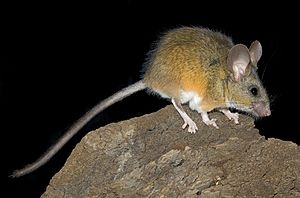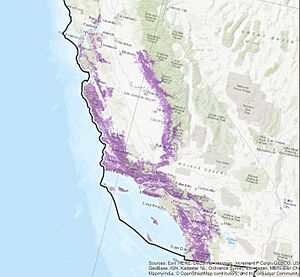California deermouse facts for kids
Quick facts for kids California deermouse |
|
|---|---|
 |
|
| Conservation status | |
| Scientific classification | |
| Genus: |
Peromyscus
|
| Species: |
californicus
|
The California deermouse or California mouse (Peromyscus californicus) is a type of rodent. It belongs to a group of mice called Neotominae within the Cricetidae family. This mouse is the only one in its special group, Peromyscus californicus.
You can find these mice in northwestern Mexico and across central to southern California. It is the biggest Peromyscus species living in the United States. Most rodents have many partners, but the California deermouse is different. It is monogamous, meaning it usually has only one partner for life. They form strong pair bonds. This makes them a model organism for scientists. Researchers study them to learn about how animals form partnerships and how fathers help take care of their young.
Contents
What Does the California Deermouse Look Like?
The California deermouse has very big ears. Its tail is longer than its head and body put together. The tail can be about 117 to 156 mm (4.6 to 6.1 in) long. The total length of the mouse, including its tail, is usually between 220 to 285 mm (8.7 to 11.2 in).
Their fur is mostly orange, mixed with black and brown hairs. This darker color on their back fades to a creamy-white color on their belly. Their front paws (called manus) and feet are white. Adult California deermice are quite large. Sometimes, they can be mistaken for young woodrats, which are close relatives.
How Do California Deermice Raise Their Young?
The California deermouse likes to climb trees a little bit, but it usually builds its nest on the ground. They often build nests under things like fallen logs. Sometimes, they even move into nests built by woodrats for a season.
They build their nests using rough, dry grasses, weeds, and small sticks. They use fine grass to make a soft bed in the middle of their nest. California mice form strong pairs, and the male mouse helps raise the babies. A mother mouse usually has only two babies at a time. However, a pair can have up to six groups of babies in one year. The mother carries the babies for about 21 to 25 days before they are born. The young mice stop drinking milk from their mother when they are about five to six weeks old.
What Are Their Habits?
California deermice are very protective of their homes. Both males and females will defend their nest area. Male mice can also be aggressive towards other males. They fight by jumping, dodging, and making a special squeaking sound.
Sometimes, if a male spends too much time fighting, he might spend less time finding food for his babies. These mice talk to each other using sounds that humans cannot hear, called ultrasound. When a male and female are getting to know each other, their sounds change. They go from sounding aggressive to sounding more friendly. The way they "talk" can even help predict how strong their partnership will be. California mice are mostly active at night.
What Do California Deermice Eat?
The California deermouse eats different kinds of food. Their diet includes fruits from shrubs, seeds, and flowers. Some plants they like are Rhus integrifolia, Lotus scoparius, and Salvia apiana. They also eat grasses, small plants (called forbs), fungi (like mushrooms), and arthropods (like insects and spiders).
Who Are Their Predators?
The main animals that hunt and eat California deermice are weasels and barn owls.



